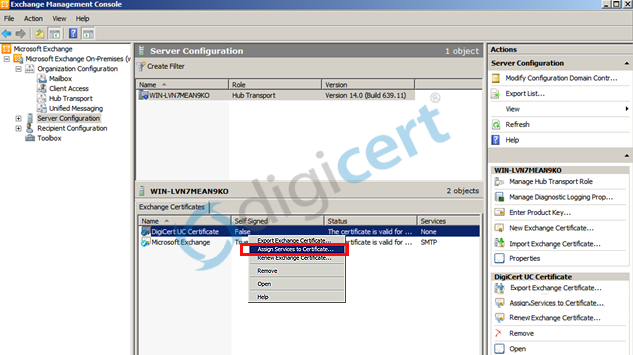
Knowledge Base
Microsoft Exchange 2010 | Configure Your Server to Use the SSL Certificate
Exchange 2010 | Use the SSL Certificate to Secure Email Connections
After importing the SSL Certificate to your Exchange 2010 server, you need to configure Exchange 2010 to use the certificate to secure email connections. Follow the instructions below to configure your Exchange 2010 server.
If you have not yet imported the SSL Certificate, see SSL Certificate Importing Instructions: DigiCert Certificate Utility.
Exchange 2010 | Configure Your Server to Use the SSL Certificate
Open Exchange Management Console.
On the Start menu, click Programs > Microsoft Exchange 2010 > Exchange Management Console.
In Exchange Management Console, under Microsoft Exchange, expand Microsoft Exchange On-Premises and click Server Configuration.

In the Server Configuration section, under Exchange Certificates, right-click on the certificate and click Assign Services to Certificate.
Note: It may take a moment for the Exchange Certificates section to populate.
Select the services that you want your new SSL Certificate to secure.
Typically, you want to select SMTP, IMAP, POP, and IIS.
Follow the instructions in the Wizard until completed.
Your SSL Certificate should now be installed on the Exchange 2010 mail domain with the services that you selected.
Test Your Installation
To verify that the installation is correct, use our DigiCert® SSL Installation Diagnostics Tool and enter the DNS name of the site (i.e., www.yourdomain.com, or mail.yourdomain.com) that you are securing to test your SSL Certificate.
Troubleshooting
If you run into certificate errors, try repairing your certificate trust errors using DigiCert® Certificate Utility for Windows. If this does not fix the errors, contact support.

